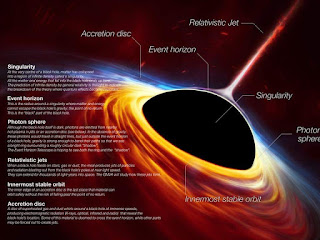#anatomy of a #blackhole
This artist’s impression depicts a rapidly spinning supermassive black hole surrounded by an accretion disc. This thin disc of rotating material consists of the leftovers of a Sun-like star which was ripped apart by the tidal forces of the black hole. Shocks in the colliding debris as well as heat generated in accretion led to a burst of light, resembling a supernova explosion.https://m.facebook.com/story.php?story_fbid=10161171725635533&id=311648465532
Since no light can escape from a black hole, we can’t see them directly. But their huge gravitational influence gives away their presence. Black holes are often orbited by stars, gas and other material in tight paths that become more crowded and frantic as they’re dragged closer to the event horizon. This creates a superheated accretion disc around the black hole, which emits vast amounts of radiation of different wavelengths.
By observing this radiation from the activity around black holes, astronomers have determined that there are two main types: stellar mass and supermassive.
Since no light can escape from a black hole, we can’t see them directly. But their huge gravitational influence gives away their presence. Black holes are often orbited by stars, gas and other material in tight paths that become more crowded and frantic as they’re dragged closer to the event horizon. This creates a superheated accretion disc around the black hole, which emits vast amounts of radiation of different wavelengths.
By observing this radiation from the activity around black holes, astronomers have determined that there are two main types: stellar mass and supermassive.
Credit: ESO, ESA/Hubble, M. Kornmesser/N. Bartmann



Comments
Post a Comment